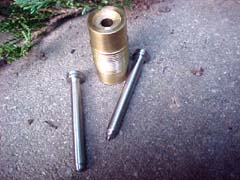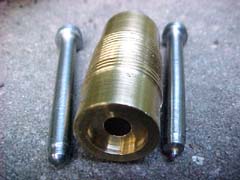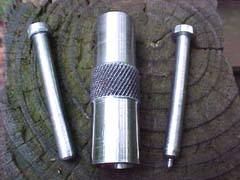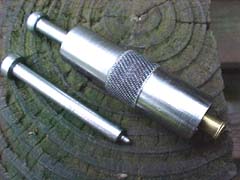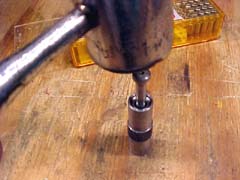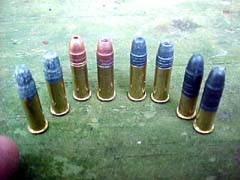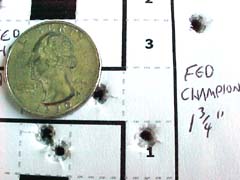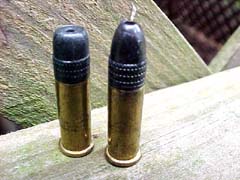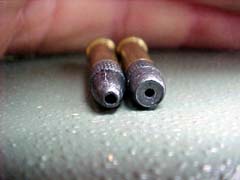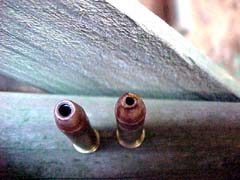| Paco Kelly's
RimFire Bullet Tool
.22 Acu'rzr and Nastinose | |
|---|---|
|
by Jeff Quinn photography by Jeff Quinn September 2nd, 2002 For the past three months, I have been carefully experimenting with (read that "playing with" ) a new rimfire bullet tool that was developed by, and is manufactured and marketed by, Paco Kelly of Tucson, Arizona. I was first introduced to the new tool, and to Mr. Kelly, at the 2002 Shootists Holiday in Raton, New Mexico. Paco has been a shooter and experimenter for many years. To him, like many of us, one activity goes with the other. He is constantly searching for ways to make something work better, go faster, and hit harder. The tool consists of three simple parts; simple to use, that is, but painstakingly made to exacting tolerances. The main body of the tool is a round bar into which the .22 cartridge is inserted to have the bullet nose reformed and resized. The cartridge can be inserted into either end, with a resulting different bullet diameter, depending upon which end is selected. This gives the shooter a choice, depending upon the gun in which the cartridge will be fired. The other two pieces of the tool are the rods which actually reform the nose and diameter of the bullet. The only other tool needed is a mallet, in addition to a flat hard surface onto which the tool will be used. Since the tool has two distinct and different functions, we will address them separately. The ACU'RZR The first reason for the development of the tool was to improve accuracy in a .22 rimfire firearm. .22 chamber dimensions vary greatly among the vast array of pistols, revolvers, and rifles available. Ammunition manufacturers must make their product to fit in all of the various chamber sizes, resulting in ammo that has undersize bullets for the majority of the guns in which they will be fired. This is fine and dandy for casual plinking, but sorely lacking to achieve optimum accuracy. Many serious shooters sort their ammo according to bullet size, but it occurred to Paco that there had to be a better way, so he developed his tool to size the bullet to the gun, instead of searching for a bullet that will fit properly into the firearm's chamber. Resizing the bullet to fit the chamber snugly should, theoretically, improve accuracy. To test Paco's theory, I selected a variety of firearms and ammunition to compare un-sized factory ammunition against ammo which had been run through Paco's ACU'RZR tool. I have tried, over the past three months, Paco's ammo in other guns, but for this bench session I selected two rifles and two handguns. The rifles used were a Marlin Model 39 lever action, and a Remington Model 581 bolt gun. Neither of these are considered target rifles, but both exhibit good hunting accuracy. The handguns used were a new Smith & Wesson AirLite Kit Gun, and a Ruger MK-512 bull barreled semi-automatic pistol. This selection of weapons is representative of most commonly owned .22 firearms, without getting into specialized target guns. The ammunition tested for this article is also representative of that available commonly on the market, and consisted of Federal Champion standard velocity solid, Remington Cyclone lead hollow point, Aguilasixty grain sub-sonic, Winchester X-Pert high velocity hollow point, and CCI Mini Mag plated hollow point. To use the tool, a .22 Rimfire cartridge, whether it be .22 Short, Long, or Long Rifle, is inserted into the tool body, the ramrod placed into the opposite end, and the tool placed on a flat, hard surface. I used the wood surface of my loading bench, but a piece of plate glass or smooth steel can also be used. Next, the head of the ramrod is gently whacked with a mallet. This process bumps up the diameter of the soft lead bullet and makes a dimple, or cupped area, on the nose of the bullet. The bullet now fits snugly into the chamber, and the bullet has a more efficient shape, to impart greater tissue damage to the target. When first learning to use the ACU'RZR, I had a tendency to whack the ramrod with the hammer too hard, as can be seen by the radical reformation of the bullet nose in the accompanying photos. I soon learned that it was unnecessary to reform the bullet this drastically to achieve an increase in bullet diameter. While the radically reformed bullets worked well in the Marlin rifle and the Smith revolver, they would not feed in the auto pistol or the 581 bolt gun. After learning to use a softer touch, I gently whacked the ramrod and achieved much better results with the other two firearms. A little experimenting will give the desired results without grossly deforming the bullet nose. After shooting many five-shot groups with all of the test guns and various ammunition, I came to the conclusion that Paco's .22 ACU'RZR will definitely affect the accuracy of .22 Rimfire ammunition. The results were varied among the different guns, and according to the ammunition used. In the two rifles, the Remington Cyclone ammo performed very poorly right out of the box, and did no better after being run through the ACU'RZR. The stuff would start to group well, and then send a bullet into the next zip code. Chronographing the ammo proved that the inaccuracy was due at least in part to inconsistency of the powder charge. This particular lot of Cyclone is good for plinking at large targets. It is poor ammo, and the ACU'RZR could not improve it. While the Aguila SSS subsonic ammo performed consistently, it benefited only a small amount from the ACU'RZR. It performed better in the handguns than in the rifles, perhaps due to the shorter range at which they were tested. I tested the handguns at 25 yards, as both were open sighted. The rifles both wore scopes, and were group tested at a range of fifty yards. This is the range at which I sight in all of my .22 Long Rifle chambered rifles. It gives a good trajectory out to 100 yards. Past that, I use a more powerful cartridge. I was beginning to doubt if the ACU'RZR was worth the trouble. That was before testing the CCI Mini Mag and Federal Champion ammo. In the 581, the CCI was pretty accurate from the start, but improved about 25 percent with the ACU'RZR. In the lever gun, the ACU'RZR cut the group size by half. In the 581, the ACU'RZR cut the group size of Federal Champion from one and three-quarters down to nine-sixteenths of an inch! That is an amazing change, and well worth the trouble of whacking a few strokes of the mallet. Winchester X-Pert ammo also benefited greatly from the ACU'RZR tool. In the Ruger pistol, all ammo tested showed improvement with the ACU'RZR, even the Cyclone ammo. The best in this very accurate pistol was the Winchester ammo. In the S&W Kit Gun, with the exception of the Cyclone and Champion, which exhibited no change, accuracy was improved with the ACU'RZR. In no case did the tool hurt the accuracy of any gun, but it is important to note that the point of impact does change when using the ACU'RZR, so the gun must be sighted for use with the tool. This is due to a slight increase in velocity and pressure, resulting in differing barrel harmonics than with standard ammo. This was most noticeable in the rifles. These tests prove that the ACU'RZR does indeed improve accuracy, sometimes dramatically, depending upon the ammunition used. Poorly made ammo is still going to shoot poorly, but most ammo on the market is good stuff and will benefit from the use of Paco's ACU'RZR when it comes to accuracy. The NASTINOSE Now we come to what I consider to be the most interesting part of the ACU'RZR tool: the NASTINOSE ramrod. The blunt ramrod discussed in the previous section of this article leaves the bullet with a blunt and cupped nose shape, which is definitely an improvement over the factory round nose product, but the NASTINOSE leaves the bullet with a real, honest-to-goodness hollow point. While factory hollow points are effective, they are a compromise to reliable feeding, penetration, and expansion. The NASTINOSE gives the bullet a deep hollow point with vertical sides to induce rapid, radical expansion, even with standard velocity ammunition. The NASTINOSE will even cause some of the lower velocity ammunition on the market to expand, allowing the shooter to use a quieter load when necessary, and still get good expansion. Without going into the full details of the tissue damage tests, I can state with absolute certainty that the effect on small vermin is dramatic. Observations on how a bullet performs on living creatures is somewhat subjective and cannot easily be measured as can the accuracy of a cartridge, but after studying the results of the NASTINOSE on several pests and small predators, I remain very impressed. The NASTINOSE hollow point bullets kill all out of proportion to what we have come to expect from a .22 Long Rifle on small creatures. Conclusions After testing the ACU'RZR for these few months, I have come to really appreciate the little tool. As with most really great inventions, the simplest ones seem to be the most useful. Paco Kelly has hit on a real winner with this little tool. You can order the tool direct from Paco. www.LeverGuns.com It is a great little tool at a fantastic price. It is simple, easy to use, built with craftsmanship, and it works. I highly recommend it. Jeff Quinn Send mail to
WebMaster@GunBlast.com
with questions or comments about this web site.
|
Click pictures for a larger version.
UPDATE! We just received this new and improved version made from precision machined bronze, with steel rods. The newer version is available now at no increase in price.
Paco Kelly's nifty .22 kit includes the ACU'RZR (left) and the NASTINOSE (right). Both tools proved very effective for their intended purposes.
Tool shown with ACU'RZR punch in place and .22 cartridge partially inserted.
A light whack with a mallet re-forms the bullet.
Bullets reformed with the ACU'RZR, shown along with unaltered examples. From left to right are Federal Champion, CCI Mini Mag, Winchester X-PERT, and Aguila SSS.
"Before and after" pictures of groups fired with federal Champion ammo show the dramatic accuracy improvement possible with Paco Kelly's ACU'RZR tool.
Author tested the ACU'RZR with several different loads in a Marlin Model 39 (top), a Remington Model 581 (center), a Ruger MK-512 (lower left), and a Smith & Wesson Model 317 AirLite (lower right).
In his initial testing of the Paco Kelly tool, Jeff got a bit hammer-happy and radically re-formed his first batch of bullets. He quickly figured out that this amount of re-forming is not necessary, and can lead to feeding problems. CCI Mini Mag after using the NASTINOSE tool (left) shown with a standard Mini Mag for comparison (right). The huge hollow point created by the NASTINOSE leads to greatly improved killing power. |
